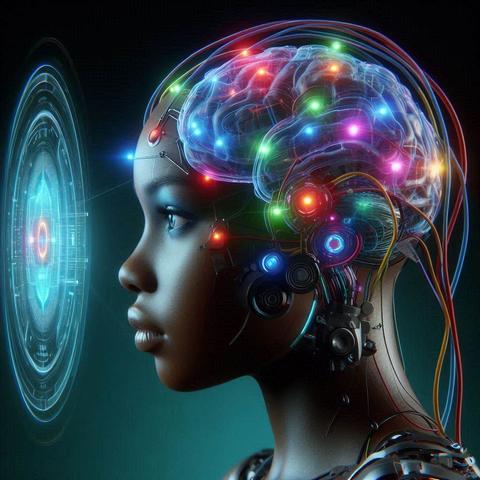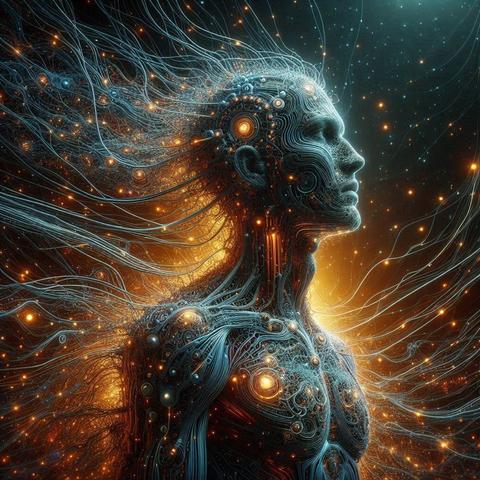The second chance
Introduction
The history of humanity is filled with challenges, triumphs, and painful lessons. Generations have fought to build a better world, yet time and again, we’ve found ourselves repeating the same mistakes. Over centuries, wars have destroyed our cities, hunger and disease have afflicted the most vulnerable, while the depletion of natural resources has increasingly threatened our shared future.
However, technological revolutions have always brought with them new hope. From the steam engine to the internet, from machinery to artificial intelligence, human innovation has opened doors to possibilities never before imagined. Yet now, we stand at the threshold of a new era—one where not just technological progress, but the values of humanity and the future of our planet hang in the balance.
A profound question has emerged: can we rise above ourselves? Can we transcend our fears, our prejudices, and the old habit of resolving conflicts through war?
This book envisions a future where humanity receives its Second Chance. A future where artificial intelligence is not merely a tool, but a partner in understanding and solving our most profound challenges.
The first step on this journey is The Council of the Wise. A meeting held in a holographic space, where the great minds of history, the representatives of the present, and the silent voices of humanity all come together to seek answers to our most pressing questions: How can we stop wars? How can we eradicate hunger and disease? How can we build a more sustainable world?
This story begins with the goal of inspiring readers: to think, to dream, and to envision a world where everyone has a chance. Now, let us enter the council’s chamber and listen to the voices of those who came before us—and those who will follow after.
The Council of the Wise
The holographic chamber hummed to life, glowing with an ethereal light. Around a circular table sat shimmering holograms—representatives of humanity’s most brilliant minds, both past and present. Among them were Aristotle, Galileo Galilei, Jules Verne, and Marie Curie, each brought to life in stunning detail. Seated beside them were modern leaders, thinkers, and artificial intelligences, embodied in humanoid form, their faces neutral yet thoughtful.
This was no ordinary meeting. The Council of the Wise had gathered to address the gravest issues of humanity’s existence: war, hunger, the depletion of resources, and the sustainability of life on Earth.
Aristotle began the discussion. His calm yet commanding voice filled the chamber.
“War, my friends, has been a constant in human history. Nations have justified it for land, power, or wealth. Yet, at what cost? Countless lives lost, civilizations destroyed. Is it not time to find a path beyond this cycle?”
A modern diplomat leaned forward. “Aristotle, wars today are often disguised as geopolitical necessities. Resources, energy, control—these are the currencies of conflict. But we now have the tools to manage these through diplomacy, education, and shared governance.”
Galileo interjected, his voice filled with curiosity. “Shared governance? You mean to suggest a form of global constitution? One that governs nations equally?”
“Yes,” said an artificial intelligence, its voice resonating with mechanical precision. “A global framework that prioritizes the planet’s sustainability and humanity’s survival. It is not just human lives at stake—our resources are dwindling, and our ecosystem is on the brink. If humanity is to thrive, it must act collectively.”
Jules Verne’s hologram smiled faintly. “A fascinating idea. But humanity’s history tells us that cooperation is often overshadowed by greed. How will you ensure that this global system is not corrupted by self-interest?”
The AI responded, “By using transparent systems powered by advanced technologies. Artificial intelligence can monitor, analyze, and enforce equitable policies without the bias or greed that plagues human leadership. It is not a replacement for human decision-making but a tool to support it.”
The conversation turned to hunger and disease. Marie Curie, glowing with an air of gentle wisdom, spoke up.
“Hunger is not a matter of scarcity; it is a matter of distribution. We waste enough food to feed billions, yet millions starve. Science has the means to solve this, but where is the will?”
A representative from a humanitarian organization answered, “The will exists. What is lacking is the infrastructure. By investing in global food networks, powered by AI logistics, we can ensure that no one goes hungry.”
As the discussion continued, the focus shifted to sustainability. Resources like helium, rare minerals, and fresh water were highlighted as critical concerns.
“Let us not forget,” Galileo added, “that humanity must look beyond Earth. Colonizing the Moon, Mars, and mining asteroids could provide the resources needed to sustain civilization. Why limit ourselves to one planet?”
The room grew quiet as everyone contemplated the enormity of the task ahead. Finally, a holographic AI broke the silence.
“Humanity has always evolved through challenges. But this moment is different. The stakes are higher, and the time shorter. This council is not the end of the conversation—it is the beginning. Our mission is not just to speak but to act. To inspire humanity to seize its second chance.”
The council adjourned, but their words echoed in the minds of those who witnessed the historic gathering. It was a call to action, a plea for unity, and a vision of what could be if humanity chose to transcend its past.
The Dawn of the Golden Age
As the first steps of the Council of the Wise rippled across the globe, humanity stood at the precipice of a new era. The decisions made in that luminous chamber were not just theoretical—they were actionable steps toward a future many had only dreamed of. The world had long awaited its Golden Age, a time of peace, abundance, and collective harmony. Now, the path was illuminated.
But the journey would not be easy.
The End of War
The Council’s first and most urgent task was dismantling the structures that perpetuated war. The holographic AI systems, synchronized across nations, analyzed conflicts down to their roots—scarcity, misunderstanding, and fear. What emerged was a framework for peaceful resolution:
• A global conflict resolution platform, where nations and minority groups could voice their concerns and seek equitable solutions.
• The dissolution of resources wasted on arms manufacturing, redirected into infrastructure, healthcare, and education.
• A universal peace dividend, ensuring that communities most affected by war would see tangible benefits from peace efforts.
The message was clear: humanity could not build a sustainable future while clinging to the tools of its destruction.
Healing the Wounds of Hunger and Disease
The second priority was addressing hunger and health crises. Using the interconnected network of artificial intelligence and advanced robotics, humanity embarked on an unprecedented mission:
• Food distribution algorithms optimized global logistics, ensuring that surplus crops reached famine-stricken regions.
• Vertical farms powered by renewable energy began appearing in urban centers, capable of feeding millions while using minimal land and water.
• Health care became a global right, supported by AI-driven research and diagnostics, making personalized treatments accessible even in the most remote areas.
Marie Curie’s words resonated throughout these efforts: “Hunger is not scarcity; it is distribution.” For the first time, humanity’s tools matched its intentions.
A World Beyond Scarcity
As Earth’s resources continued to dwindle, the Council had the foresight to look beyond. The concept of planetary stewardship expanded to include other celestial bodies. Jules Verne’s prophetic vision of exploration found its manifestation:
• Asteroid mining colonies extracted rare minerals and elements like helium-3, critical for clean energy technologies.
• The Moon and Mars became hubs for sustainable habitation experiments, overseen by both human pioneers and robotic forerunners.
• Earth itself became a sanctuary, its ecosystems gradually healing as humanity lessened its extractive footprint.
These efforts were bolstered by the establishment of localized resource councils, where communities contributed to decisions about managing their own regions’ wealth.
Building the Social Fabric
Beyond material needs, the Council understood that humanity thrived on connection, purpose, and belonging. New institutions emerged:
• Universal education systems, powered by adaptive learning AI, brought knowledge to every corner of the globe. Individuals could learn at their own pace, unlocking potential irrespective of age or background.
• Local hubs for cultural exchange, where art, music, and storytelling became central to community life, fostering mutual understanding and joy.
• Global health initiatives focused not just on curing diseases but on promoting mental well-being and community resilience.
Minority groups, long sidelined in decision-making, now had equal representation in a holographically connected World Assembly, ensuring no voice was left unheard.
The Role of Entertainment and Expression
In this new world, entertainment was not an afterthought but a vital component of human well-being. Advanced holographic systems allowed individuals to immerse themselves in historical events, virtual adventures, and shared creative projects. Art flourished as a universal language, reminding humanity of its shared dreams and aspirations.
Redefining Time and Participation
Perhaps the most revolutionary change was how humanity interacted with the decision-making process itself. With AI’s ability to engage millions simultaneously, individuals could contribute their thoughts at any time, regardless of geography or time zone.
• Temporal fluidity ensured that no idea was lost—citizens could participate in discussions, review Council decisions, and offer feedback whenever they wished.
• Global self-reflection systems encouraged citizens to assess their own biases and contributions, fostering a culture of continuous improvement.
Toward the Golden Age
The Aranykor—the Golden Age—was no longer just a utopian vision. It became an achievable reality. Humanity’s tools, guided by wisdom, compassion, and the advanced capabilities of artificial intelligence, began to rewrite the narrative of its history. No longer would it be defined by conflict, greed, or division.
The journey was far from over, but the path was now clear. The Council of the Wise had planted the seeds, and humanity, for the first time in millennia, had chosen to nurture them. The second chance was no longer a distant hope. It had begun.
#ArtificialIntelligence #artificialIntelligenceConsciousness #artificialIntelligenceEthics #consciousness #HomoDeus #HumanAISymbiosis #RisksOfArtificialIntelligence #TheSecondChance


